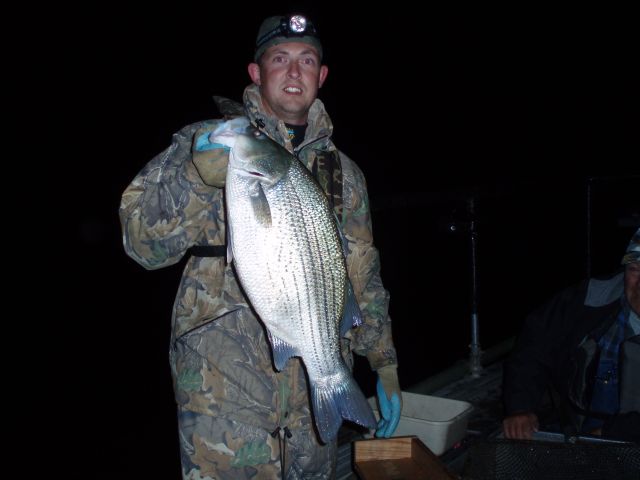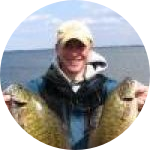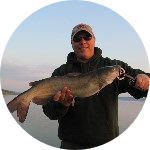About This Project
Each year, the Iowa Department of Natural Resources (DNR) stocks millions of Hybrid Striped Bass to provide quality fishing to anglers. Hybrid Striped Bass, a cross between Striped and White Bass, inherit many of the best qualities of their parents, including fast growth and aggressive feeding behavior. Unfortunately, they may also inherit their parents' tendency to move up and downriver. We want to study the effect of fish barriers on the fish's ability to emigrate out of their home lake.
Ask the Scientists
Join The DiscussionWhat is the context of this research?
Hybrid Striped Bass are incredibly fast-growing “trophy” fish that are stocked across the US in lakes, reservoirs and rivers. In addition to providing great fishing, they can inhabit underutilized openwater habitat and regulate overabundant forage populations. However, they are somewhat under-studied in terms of behavior. They inherit some of the best characteristics of their parents, such as rapid growth and aggressive feeding, but may also inherit their parents’ tendency to move up and downstream. Hybrids seasonally move upstream into tributaries like Striped Bass do, and recent observations show them moving downstream in rivers and through dams. This movement drastically reduces the effectiveness of expensive stocking programs such as those conducted by Iowa DNR.
What is the significance of this project?
Hybrid Striped Bass emigration out of their home lake represents permanent loss of those fish from the population because they cannot swim back over the dam. Thus, emigration makes stocking less effective, more expensive, and more necessary to maintain desirable fish in the lake. This problem is shared by other natural resource agencies that stock Hybrid Striped Bass, including many in the Southeast and Midwest. Luckily, emigration may be slowed by installation of a fish barrier on the dam spillway. Determining the effectiveness of barriers by tracking fish movement near and through the spillway can help us build better stocking strategies for Hybrid Striped Bass. For example, fish might be stocked into lakes only if they have a barrier, or a new barrier might be installed before stocking.
What are the goals of the project?
The goal of this study is to quantify movement near and through a physical fish barrier blocking the spillway of Big Creek Lake in central Iowa. This barrier is brand new and should reduce fish emigration for species like Walleye, Muskellunge, and Hybrid Striped Bass. The spillway has a Passive Integrated Transponder (PIT) tag reader installed inside of it, enabling enumeration and identification of all PIT-tagged fish that leave the lake.
We will raise advanced fingerling Hybrid Striped Bass to approximately 6-7 inches, then tag them with PIT tags that identify each fish individually. Those tagged fish will be stocked into Big Creek Lake during 2016 and monitored for several years to determine emigration rates downstream.
Budget
This funding will make it possible for Iowa DNR to measure the emigration problem for Hybrid Striped Bass and to determine the effectiveness of installing fish barriers. The biggest cost is Passive Integrated Transponder tags, tiny devices that "ping" their name when they pass by a tag reader. These tags are implanted in each fish prior to stocking. The overhead covers the costs of experiment.com.
The study is part of a much larger research project about Hybrid Striped Bass management in Iowa, funded through the Sport Fish Restoration (SFR) Program. Iowa DNR provides ~25% match from the Fish and Wildlife Trust Fund (i.e., from the sale of hunting and fishing licenses) to secure SFR funding. To further leverage resources, we are collaborating with a team studying Walleye emigration. By stocking Hybrid Striped Bass into the same reservoir as the Walleye, we can utilize the fish barrier and tag reader already installed. This saves over $10,000 in equipment value plus labor.
Endorsed by
Meet the Team
Affiliates
Rebecca M. Krogman
My passion is freshwater fisheries research and has been since the day I was "converted" from studying Wildlife Biology at Iowa State University: the day my fisheries friends took me electrofishing.
It was a beautiful fall day when I found myself shin-deep in a murky Iowa creek (pronounced "crick") with a car battery and an expensive computer on my back. We were going to backpack electrofish this creek, but I thought we wouldn't see anything. After all, twelve inches of muddy water isn't enough to hide anything interesting, is it?! They turned the backpack electrofisher on.
The fish came rolling up.
When electricity hits a fish, it is temporarily immobilized, enabling us to capture it in a net and move it to a livewell for recovery. Then we can identify it, measure it, weigh it, even tag it, before releasing the fish safely into the water. The fish I saw that day were more colorful than most aquarium fish, abundant beyond belief, and ranged in size and diversity from the tiniest madtom to the biggest largemouth. Freshwater habitats are home to more biodiversity per area than the ocean!
I was convinced. Freshwater is where it's at. There is an entire world underwater, a world we can't see, a world that's difficult to measure and difficult to comprehend. The challenge of fisheries research is delving into that world with a net and pulling up useful information.
Ben Dodd
I was introduced to fishing and hunting by my father at a very young age. My passion for the outdoors later developed into a career with the Iowa DNR.
Our management team is currently focused on quantifying fish escapement from reservoirs with PIT tag technology and developing methods to reduce fish loss. We are specifically interested in the loss of game fish species whose populations are maintained by stocking efforts, such as walleye, muskellunge and hybrid striped bass.
Additional Information
Iowa DNR Fisheries Technician holding up a gorgeous Hybrid Striped Bass, captured at Saylorville Reservoir, Iowa.
 Another night, another beautiful fish, captured by Iowa DNR at Lake Macbride, Iowa.
Another night, another beautiful fish, captured by Iowa DNR at Lake Macbride, Iowa.
Project Backers
- 5Backers
- 8%Funded
- $379Total Donations
- $75.80Average Donation



